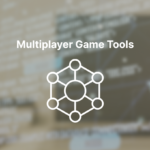Node.js and React Native: 2 Powerful Multiplayer Game Tools
There’s a plethora of reasons why building a multiplayer game using React Native and Node.js comes in as a popular choice among game developers. Let’s go over some:
Cross-platform compatibility: React Native allows developers to build games that can be played on both iOS and Android devices. So, your target audience is larger.
Fast and efficient development: React Native provides pre-built components and libraries, allowing a quick polished user interface creation.
Node.js is fast and scalable: Node.js is known for its speed and scalability. It handles a large number of simultaneous connections and requests, ideal for a multiplayer game.
Large community support: Both React Native and Node.js have large and active developer communities, with access to a wealth of resources, libraries, and support.
Real-time communication: Node.js provides real-time communication capabilities, essential for multiplayers. Enables interaction in real-time, providing an immersive experience.
Sample of node.js real-time communication code for you to get up and running!
It involves setting up a server and using a library or framework to handle real-time communication between clients. Here’s a general overview of the steps you can follow:
Set up a Node.js server: Start by setting up a Node.js server that can handle real-time communication between clients. You can use a library like Socket.IO to handle real-time communication.
Install Socket.IO: Install Socket.IO using the following command in your terminal:
npm install socket.ioInitialize Socket.IO: Initialize Socket.IO in your Node.js server using the following code:
const app = require('express')();
const http = require('http').Server(app);
const io = require('socket.io')(http);Handle incoming connections: Use the following code to handle incoming connections and disconnections:
io.on('connection', (socket) => {
console.log('A user has connected.');
socket.on('disconnect', () => {
console.log('A user has disconnected.');
});
});Emit events: Use the following code to emit events to clients:
io.emit('event_name', data);Handle incoming events: Use the following code to handle incoming events from clients:
socket.on('event_name', (data) => {
// Handle the incoming data
});Test the server: Test the server by connecting multiple clients to it and testing the real-time communication features.
This is a basic overview of how to create real-time communication for a multiplayer game in Node.js using Socket.IO.
You may need to tailor the code depending on specific requirements or use additional libraries or frameworks to handle more complex features.
Ready to use it? Go ahead and let us know how it was.
To sum up, using React Native and Node.js for building a multiplayer game allows you to create high-quality games that are fast, scalable, and provide a great UX.
Planning and design are crucial when it comes to various aspects of game design, including mechanics, gameplay, and features, for five main reasons:
- Ensuring Consistency is of paramount importance. The mechanics, gameplay, and features of a game ensure consistency throughout the game, so players understand and engage with the game more easily.
- Identifying potential problems or limitations that might arise during the game’s development lets you cater to these issues early on, avoiding costly and time-consuming late-fixes.
- Improving User Experience; mind the design, the mechanics, gameplay, and features of a game work together cohesively to create a seamless and engaging experience for players.
- Streamlining Development enables you to have a clear roadmap of what needs to be done and how it should be done, it makes work efficient and effective so as to bring the game to completion.
- Meeting Player’s Expectations. By having a clear understanding of what players are looking for in a game, developers incorporate those features and mechanics into the game’s design, making it aim at the target audience.
To round up, planning and design are a must. So, take the time to painstakingly blueprint the mechanics and features to create a more cohesive and enjoyable experience, while also streamlining the development process and meeting players’ expectations.
Game Engines That Match With node.js and React Native
There are several game engines that can be used to build free online multiplayer games using Node.js and React Native. Among some popular options you might find the following:
Unity 🇫🇷 is a widely-used game engine that supports cross-platform development. It has a large community and a robust set of tools for developing and testing multiplayer video games.
However, its learning curve can be a bit steep and resource-intensive, which means that smaller projects may prefer a different approach.
Unreal Engine 🇺🇲 supports cross-platform development and has a strong focus on best online multiplayer games. It has a powerful visual scripting system, accessible to developers with varying levels of experience.
But, Unreal Engine also has a steep learning curve and may require more powerful hardware to run smoothly.
Godot Engine 🇫🇷 is a free and open-source game engine that has been gaining popularity in recent years. It has a user-friendly interface that makes it accessible to developers of all levels.
There’s a caveat, Godot Engine may not have the same level of community support and third-party tools as Unity and Unreal Engine.
Phaser 🇬🇧 is a 2D game engine that is often used for developing browser-based games. It has a robust set of features, including physics engines and particle systems.
Bear in mind that Phaser may not be as suitable for developing larger, more complex games as Unity or Unreal Engine.
Trip down memory lane → When choosing a game engine for developing multiplayer game for mobile with Node.js and React Native, it’s important to consider factors such as: scope, target platform, and development team’s skills and experience.
Each game engine has its own benefits and drawbacks, so it’s important to choose one that best meets the specific needs.
The Backend World
- Install Node.js: You can download and install Node.js from the official website (https://nodejs.org/en/download/). Follow the instructions for your operating system.
- Create a new Node.js project: Once Node.js is installed, you can create a new Node.js project. Open your terminal and navigate to the directory where you want to create the project. Then run the following command:
npm initThis will prompt you to enter some information about the project, such as the name and version. You can accept the default values or enter your own.
- Install the necessary packages and libraries: To install the necessary packages and libraries, you can use NPM. Here’s an example of how to install the Express framework, which is commonly used for web applications and games:
npm install express --saveThis will install the latest version of Express and save it as a dependency in your project’s ‘package.json’ file. You can also install other packages and libraries as needed for your game.
- Set up the server file: Once the necessary packages and libraries are installed, you can set up the server file. Here’s an example of a basic server file that uses Express:
const express = require('express');
const app = express();
app.get('/', (req, res) => {
res.send('Hello World!');
});
const server = app.listen(3000, () => {
console.log('Server started on port 3000');
});This code sets up an Express server that listens on port 3000 and responds with “Hello World!” when the root URL is requested.
You can customize this code to implement the game logic, manage communication between players, and handle user authentication and game sessions.
We hope this triggers ideas so you get hands on!
When it comes to implementing game logic the server file should handle all gameplay mechanics. This includes managing player movements, updating game state, handling collisions, and scoring.
Another key element is communication between players which is critical for a shooting multiplayer game. The server should be responsible for handling all communication between players, such as sending updates about player movements and game state.
This is typically done using WebSockets, which provide a low-latency, bidirectional communication channel between the server and the players.
Safety is an asset! To prevent unauthorized access and ensure fair play, it is important to implement user authentication on the server.
The server should be able to create, manage, and destroy game sessions as needed. This includes keeping track of player scores, managing player connections and disconnections, and ensuring that games are fair and balanced.
Scale it up! As more players join a game session, the server may become overloaded. So…
To prevent this, it is important to design the server to be scalable. This can be done using techniques such as load balancing, where multiple servers are used to distribute the load of incoming requests.
The Frontend World
Some key functionalities that can’t be overlooked, let’s go over them:
Chat
To implement this in React Native, you can use a library like Gifted Chat to create a chat interface.
On the backend, you’ll need to set up a system for handling chat messages, which might involve storing messages in a database or broadcasting them to other players in real-time using a library like Socket.io.
For the frontend:
import React, { useState, useEffect } from 'react';
import { GiftedChat } from 'react-native-gifted-chat';
import io from 'socket.io-client';
const ChatScreen = ({ navigation, route }) => {
const [messages, setMessages] = useState([]);
useEffect(() => {
const socket = io('http://your-backend-url.com');
socket.on('chat message', (msg) => {
setMessages((prevMessages) => GiftedChat.append(prevMessages, msg));
});
return () => socket.disconnect();
}, []);
const onSend = (newMessages) => {
setMessages((prevMessages) => GiftedChat.append(prevMessages, newMessages));
const socket = io('http://your-backend-url.com');
socket.emit('chat message', newMessages[0].text);
socket.disconnect();
};
return (
<GiftedChat
messages={messages}
onSend={(newMessages) => onSend(newMessages)}
user={{ _id: 1 }}
/>
);
};
export default ChatScreen;For the backend:
const io = require('socket.io')(server);
io.on('connection', (socket) => {
console.log('a user connected');
socket.on('chat message', (msg) => {
console.log('message: ' + msg);
io.emit('chat message', [{
_id: new Date().getTime(),
text: msg,
createdAt: new Date(),
user: { _id: 2, name: 'Server' },
}]);
});
socket.on('disconnect', () => {
console.log('user disconnected');
});
});This code sets up a Socket.io connection on the server-side and listens for ‘chat message’ events from clients. When a message is received, the server broadcasts the message to all connected clients.
On the client-side, the code sets up a Socket.io connection and listens for ‘chat message’ events from the server. When a message is received, the code updates the state of the chat messages and displays them using Gifted Chat.
When a new message is sent, the code emits a ‘chat message’ event to the server, which in turn broadcasts the message to all connected clients.
Matchmaking
It’s about pairing players with others of similar skill levels or preferences. You can use a library like Agones to manage game sessions and match players.
On the frontend, you’ll need to create a UI for players to search for and join matchmaking sessions.
On the backend:
- Install and set up Agones on your Node.js server.
- Create a matchmaking service that uses Agones to manage game sessions and match players based on desired criteria. Here’s an example using the Agones SDK for Node.js:
const { GameServerSDK } = require('agones-nodejs-sdk');
const agones = new GameServerSDK();
// Matchmaking function to match players based on skill level and location
const findMatch = (player) => {
const { skillLevel, location } = player;
// Find other players with similar skill level and location
const matchingPlayers = players.filter((p) => {
return p.skillLevel === skillLevel && p.location === location;
});
// Create a game session with the matched players using Agones
const sessionName = `match_${Math.random().toString(36).substring(2, 8)}`;
agones.createGameServer(sessionName, {
players: matchingPlayers
});
}
module.exports = { findMatch };- Import the matchmaking service into your Node.js server and expose it as an API endpoint.
On the frontend:
- Install the Agones SDK for React Native and import it into your project.
- Create a UI for players to search for and join matchmaking sessions. Here’s an example using React Native:
import React, { useState } from 'react';
import { View, Text, Button } from 'react-native';
import { AgonesSDK } from 'react-native-agones-sdk';
const agones = new AgonesSDK();
const MatchmakingScreen = () => {
const [isSearching, setIsSearching] = useState(false);
const handleMatchmaking = async () => {
setIsSearching(true);
const result = await agones.callServerFunction('findMatch', { skillLevel: 5, location: 'US' });
console.log(result);
}
return (
<View>
<Text>Matchmaking Screen</Text>
<Button title={isSearching ? 'Searching...' : 'Find Match'} onPress={handleMatchmaking} disabled={isSearching} />
</View>
);
};
export default MatchmakingScreen;- When a player initiates a search for a matchmaking session, call the matchmaking API endpoint on the backend and retrieve the result using the Agones SDK for React Native.
- Use the result to display a list of available sessions to the player and allow them to join a session.
Game Sessions
There are other aspects to take into account, to manage game sessions in your game, you can use a library like Colyseus to create and manage game rooms.
On the frontend, you’ll need to create a UI for players to join and leave game sessions, as well as a way to display information about the current game session, such as the number of players and the current score.
Leaderboards
To implement leaderboards in your multiplayer game, you’ll need to store player data in a database and create a UI for displaying the leaderboard.
You can use a library like Firebase to store and retrieve player data, and a library like react-native-leaderboard to create the leaderboard UI.
Summing up! Taking these features as core elements in your multiplayer pc game using React Native and Node.js can be challenging, but there are many libraries and resources available to help you get started.
With painstaking planning and implementation, you can create a fun and engaging multiplayer game that keeps players coming back for more.
To unify the backend and frontend of a multiplayer game using a game engine, you can follow these general steps:
- Choose a game engine that supports both the backend and frontend development, such as Unity or Unreal Engine.
- Set up a connection between the backend server and the frontend client by creating a communication protocol that can send data between them.
- Implement game mechanics and features on both the backend and frontend sides using the same game engine, ensuring that they work together seamlessly.
- Test and debug the game to ensure that the communication and gameplay are functioning correctly.
- Optimize Performance:
A must do for building a successful multiplayer game is ensuring optimal performance, as even minor lag or delay can significantly impact player experience. Some tips for optimizing performance:
- Use efficient code and algorithms to minimize processing time
- Implement caching and other performance-enhancing techniques to minimize server load
- Use a content delivery network (CDN) to minimize latency and improve download speeds
- Regularly monitor and analyze performance metrics to identify and address bottlenecks and other issues.
- Improve Security:
Another crucial aspect of building a successful multiplayer game is ensuring security, as games can be vulnerable to hacks, cheating, and other malicious activities:
- Use secure authentication protocols to ensure only authorized players can access the game
- Implement encryption to protect player data and prevent unauthorized access
- Regularly audit and update security protocols to address emerging threats and vulnerabilities
- Use anti-cheat measures to detect and prevent cheating and other unfair gameplay practices.
By optimizing performance and improving security, you can create a more engaging and enjoyable multiplayer gaming experience for players while also protecting their personal information and preventing cheating and other malicious activities.
Let’s round up!
The key takeaways of the post are that building a multiplayer game using React Native and Node.js is a popular choice among game developers.
To build a successful multiplayer game is important to plan and design. Additionally, features such as chat, matchmaking, and game sessions are essential for a multiplayer game, so use various libraries and frameworks.
Overall, we encourage you to try building your own multiplayer game using React Native and Node.js, as it’s a rewarding and challenging project.
In future blog and instagram posts, we’ll explore specific strategies and techniques for using mobile web analytics to drive business growth and success.
So stay tuned, and don’t forget to check out our other posts for more insights on digital marketing and data analytics!





Leave a Reply
You must be logged in to post a comment.